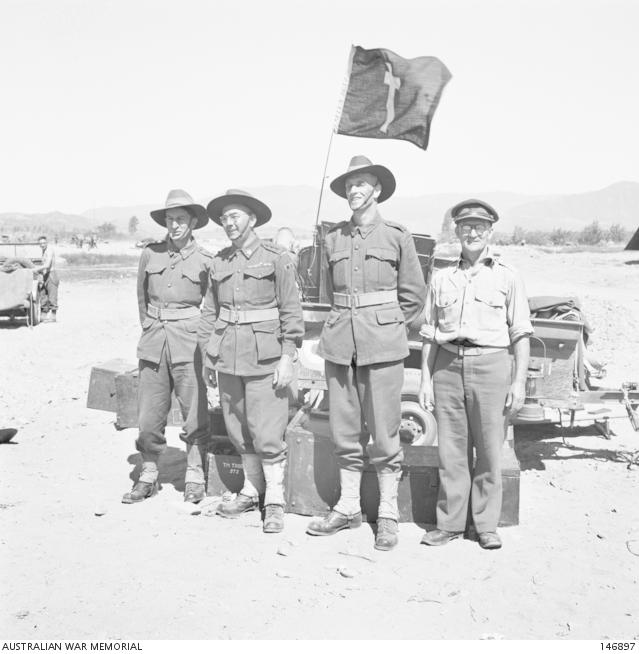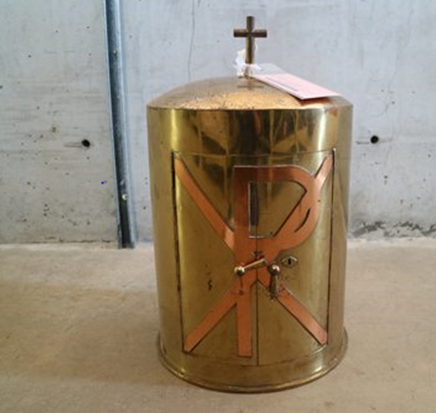Armed Only with their Faith – Australian Padres in the Korean War
The Australian War Memorial has a rich collection of records and objects relating to the service of defence chaplains, affectionately known as padres. Holdings relating to the Korean War are limited and overshadowed by the conflicts that came before and after it, but there are excellent photographs, published and private records in the Memorial’s collection.
Following a long tradition of priests accompanying armies, Australian padres in Korea volunteered for the cause and undertook little military training. They conducted services wherever possible - sometimes under fire – talked with the men, collected their mail, and distributed writing paper. Roman Catholic padres heard confession, granted absolution and performed last rites. All denominations buried the dead. The rugged mountains of Korea presented logistical challenges for chaplains, most of whom were far older than the men they served.

Taegu, Korea, 28 September 1950. Chaplains of 3RAR, three of whom had served in the Second World War. Left to right - Padre EB Phillips (RC); Padre AW Laing (C of E); Padre W Wallace (Prot.) and Major Albert Gray (Salvation Army)
Chaplain Alan Laing
Padre Alan Laing was a veteran Church of England chaplain of the Pacific War. Cheerful, friendly and practical, rather than make the men come down to him, Lang used to climb up the hills to each company area to conduct short services in their shallow dug-in positions; sometimes they would have to dive for cover, or the service would be interrupted by an artillery officer dashing up to order guns into action. “Climbing the hills for 10 or 15 services a day used to just about finish me.” He did this because he wanted to.
Padre Laing conducts a service in the field with Captain Bryan Gandevia reading the lesson. Note the sturdy (heavy) portable altar with attached candle sconces, chalice and paten, crucifix and fold out altar. Laing’s stole has his Second World War ribbon bar attached.
Chaplain Elzear Philipps
Elzear Basil Phillips, known as “Father Joe”, was a Roman Catholic priest who served with the 2nd AIF in Africa, Palestine and Syria before seeing action in New Guinea and Borneo. Phillips was a member of the British Commonwealth Occupation Force (BCOF) in Japan and served in Korea. Quiet and pious with an interest in horseracing, Father Joe became the longest serving member of his battalion. A discalced or barefoot-Carmelite priest, Phillips wore army boots without socks in a country of agonisingly cold winters. In battle, he and the other 3RAR padres positioned themselves at aid posts to assist the wounded and give final unction. Particularly at Kapyong, the 3RAR padres worked as stretcher bearers in the front line. Phillips was awarded an MBE in 1952 for his “fearless devotion to duty”.
Outdoor Mass led by Father “Joe” Phillips. Not the improvised altar – a blanket over a stretcher.
Squadron Leader Esmond New
Squadron Leader Esmond New was an Air Force chaplain of the Second World War. A minister by training, New joined the Australian Presbyterian Mission in Korea in 1934. As tensions increased in the region, Japan forced most missionaries to cease their work, and New, his wife and three sons returned to Australia in 1939.
The following year he became chaplain to the 16th Infantry Battalion in Western Australia. In 1942 he transferred to a RAAF chaplaincy. Speaking fluent Korean and Japanese and familiar with both cultures, New worked on intelligence duties before serving in Borneo and New Guinea.
After the war, New returned to the church full-time until being called up as an intelligence officer with the Special Duties Branch of the RAAF. Attached to BCOF in Japan as a UN officer, New’s knowledge of and respect for the Korean culture, and his many Korean friends qualified him for a highly unusual job. He was asked to find and retrieve the bodies of two 77 Squadron P51 pilots who had been declared missing, presumed dead, earlier in the year. In a country of “mountains beyond mountains and still more mountains”, pilots struggled with these ranges while carrying out strafing and rocket attacks.
Arriving in Korea on Christmas Day 1950, New led a small party of South Korean Commandos up the east coast and then south to Waegwan on the Nakdong River in search of the downed airmen. He was deeply saddened at the plight of hundreds of thousands of refugees, freezing children without food or shelter; a country ruined by war.
Fired at by communist guerillas, frostbitten and caught in fierce winter storms, New’s party managed to recover the remains of Squadron Leader Graham Strout and Pilot Officer Bill Harrop. The remains of both airmen were buried at the UN Cemetery at Pusan.
The burial service on 26 January 1951 for Sqn Ldr Strout and Plt Offr Harrop. Chaplain Laing conducts the service (bareheaded); leader of the search party, Esmond New, stands bottom left, next to Commanding Officer Sqn Ldr Dick Cresswell.

Tabernacle used in Kure prior to deployment to Korea by 3RAR. RELAWM32168
This heavy tabernacle, a fixed locked box for storing the Eucharist is made of brass. It has two lockable swing doors with keyhole shaped levers. Across the two doors in bands of copper is the Crismon Christian religious symbol “XP” (XPISTOS). Inside the tabernacle is a metal disc of the same diameter, covered in white cloth with a ruffled edge. On top of the tabernacle a metal cross is attached by a screw.
This tabernacle was made in Kure, Japan, by Australian Army Engineers under the direction of Father Archie Bryson. It remained in Kure at the Sacred Heart Church (built by the BCOF) until the end of hostilities in Korea in 1953, after which it was brought back to Enoggera Chapel where it remained until 1963.
Interior of Sacred Heart Chapel with funeral in progress. The tabernacle can be seen on the altar.
Padres of 3RAR and Australian service chaplains in Korea worked unflaggingly to provide spiritual and moral support for their men. Perhaps more unexpectedly, they also took on physically taxing and dangerous duties: digging graves in frozen ground, retrieving the wounded under fire, and slogging up hills to deliver comfort and friendship.
Through shared experience these padres earned intense loyalty and respect from their men. 3RAR RMO Captain Douglas Beard perhaps summed it up best when he spoke of the padres helping in the regimental aid post “they were wonderful… they’d do anything”.




